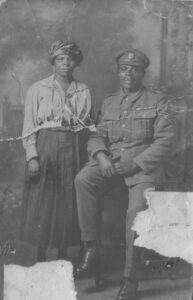When Empire Windrush docked in Tilbury on 22 June 1948, most of the passengers were ex-servicemen who had fought for Britain or the allies in the Second World War. As they were demobbed, this isn’t necessarily obvious from the passenger list itself. Take for example, Sam King who is described as a ‘Carpenter’ but who had served in the RAF during the war. Those on Windrush, however, are a small number of a very much larger number of individuals from the Caribbean who joined British armed forces over a much longer history.
That history reflects the complex connections between military service, migration and struggles for racial equality and opportunity over several centuries. Norman Manley, later Premier of Jamaica, travelled from Jamaica to Oxford in 1914 with a scholarship to study Law. He then served in the Royal Artillery in the First World War, winning the Military Medal. Yet further back, Samuel Marlow, a Jamaican, was one of ten black sailors on the HMS Bellerophon fighting with Nelson at Trafalgar in 1805 and is depicted on Nelson’s Column in Trafalgar Square. Yet beyond these now iconic figures and moments are tens of thousands lesser-known stories such as that of Alpheus Grant, of Hagley Gap, Jamaica, who served in the West India Regiment in the early twentieth century and who is depicted here with his wife Adella.

Alpheus Wicliffe Henry Grant and Adella Eugenia Lowe, at some time close to their marriage in 1914 (IWM Collection, used under the IWM non-commercial licence)
This guidance is intended for those who are exploring their own Caribbean family history and find themselves asking questions about relatives and ancestors who were part of the British armed forces: the Army, Royal Navy the Air Forces.
